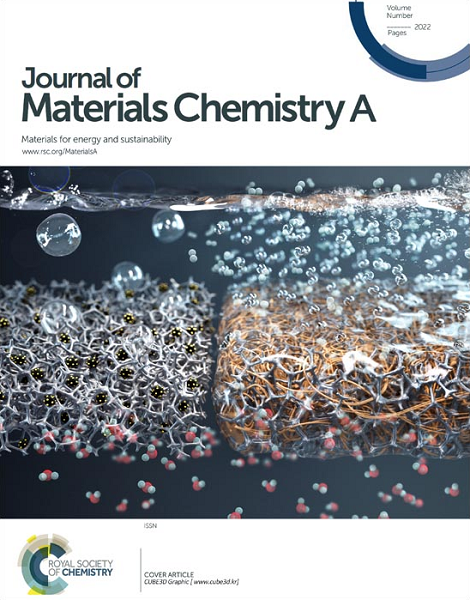Chemically bonded interface construction of covalent organic framework/CsPbBr3 heterojunction for efficient photocatalytic CO2 reduction driven by visible light
IF 10.7
2区 材料科学
Q1 CHEMISTRY, PHYSICAL
引用次数: 0
Abstract
Effective interface interaction is the key factor to improve the photocatalytic performance due to its rapid interfacial charge transport. However, the complex organic synthesis environment and abundance surface ligands for most metal halide perovskites (MHPs) nanocrystals (NCs) make it difficult to realize the strong interface interaction and rapid carrier transfer. Herein, the unique covalent organic framework (COF, TpBpy)/CsPbBr3 catalyst constructed by in-situ growth of CsPbBr3 NCs on COF in hydrobromic acid (HBr) solvent is formed with chemical bond (Pb-N coordination) to enhance the CO2 photoreduction performance. The chemically bonded interface facilitates the transport of photoelectrons from CsPbBr3 NCs to TpBpy throng Pb-N bond, forming TpBpy/CsPbBr3 heterojunction with strong interface interaction and enabling the effective separation of the photoexcited electron-hole pairs. As a result, the photocatalytic efficiency of TpBpy/CsPbBr3 heterojunctions reaches up to 239.46 μmol·g–1 h–1 (CO) with a high selectivity of 99.66% under the visible light irradiation, which is significantly higher than that of pure TpBpy (24.68 μmol·g–1 h–1, 97.45%) and CsPbBr3 NCs (12.58 μmol·g–1 h–1, 97.19%) and superior to previous reports about COF/perovskite heterojunction. This work demonstrates a potential strategy for the construction of COF/MHPs heterojunction with strong interface interaction, which has great potential in various optoelectronic applications.化学键合界面构建共价有机框架/CsPbBr3 异质结,实现可见光驱动的高效光催化二氧化碳还原
由于界面电荷传输迅速,有效的界面相互作用是提高光催化性能的关键因素。然而,大多数金属卤化物过氧化物(MHPs)纳米晶体(NCs)复杂的有机合成环境和丰富的表面配体使得其难以实现强界面相互作用和快速载流子传输。在这里,通过在氢溴酸(HBr)溶剂中的 COF 上原位生长 CsPbBr3 NCs,形成了独特的共价有机框架(COF,TpBpy)/CsPbBr3 催化剂,其化学键(Pb-N 配位)提高了 CO2 光还原性能。化学键界面有助于光电子从 CsPbBr3 NCs 向 TpBpy 通过 Pb-N 键传输,形成具有强界面相互作用的 TpBpy/CsPbBr3 异质结,使光激发的电子-空穴对有效分离。因此,在可见光照射下,TpBpy/CsPbBr3 异质结的光催化效率高达 239.46 μmol-g-1 h-1 (CO),选择性高达 99.66%,明显高于纯 TpBpy(24.68 μmol-g-1 h-1,97.45%)和 CsPbBr3 NCs(12.58 μmol-g-1 h-1,97.19%),也优于之前有关 COF/过氧化物异质结的报道。这项工作为构建具有强界面相互作用的 COF/MHPs 异质结展示了一种潜在的策略,在各种光电应用中具有巨大的潜力。
本文章由计算机程序翻译,如有差异,请以英文原文为准。
求助全文
约1分钟内获得全文
求助全文
来源期刊

Journal of Materials Chemistry A
CHEMISTRY, PHYSICAL-ENERGY & FUELS
CiteScore
19.50
自引率
5.00%
发文量
1892
审稿时长
1.5 months
期刊介绍:
The Journal of Materials Chemistry A, B & C covers a wide range of high-quality studies in the field of materials chemistry, with each section focusing on specific applications of the materials studied. Journal of Materials Chemistry A emphasizes applications in energy and sustainability, including topics such as artificial photosynthesis, batteries, and fuel cells. Journal of Materials Chemistry B focuses on applications in biology and medicine, while Journal of Materials Chemistry C covers applications in optical, magnetic, and electronic devices. Example topic areas within the scope of Journal of Materials Chemistry A include catalysis, green/sustainable materials, sensors, and water treatment, among others.
文献相关原料
| 公司名称 | 产品信息 | 采购帮参考价格 |
|---|
 求助内容:
求助内容: 应助结果提醒方式:
应助结果提醒方式:


